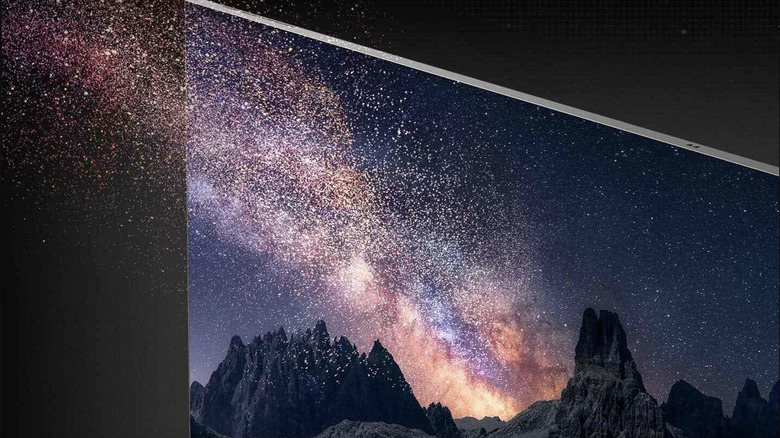Are MicroLED TVs Worth The Hype? What You Need To Know
We may receive a commission on purchases made from links.
Once upon a time, a TV was just a TV. No fancy technical names were being bandied about. For many, determining which brand was the most reliable was the most important factor in deciding which TV to buy. Still, savvy consumers did their research, for example, deciding between factors like color or black and white, tube warm-up time, tuning methods, and even the weight of the TV, something that's rarely mentioned today. As one might expect, technological advances have changed that conversation yet again. A few years ago, we had to grapple with whether plasma TVs were better than LCDs, and today, the question many are asking is if MicroLED lives up to the hype. While MicroLED technology is promising, unless you're prepared to shell out upwards of a hundred thousand dollars on your next TV, the technology remains out of reach.
However, this is the norm with new technology (think back to the first flat-screen TVs), and prices are expected to come down in the next few years, which will make these TVs affordable to a broader audience. When that happens, consumers will have one more option among many, including OLED, QLED, and MiniLED, to choose from when upgrading their home entertainment setup. If they choose a MicroLED TV, they can expect superior brightness, better color accuracy, improved energy efficiency, and a longer lifespan, to name just a few of the ways it outperforms current technologies.
Understanding MicroLED technology
As you may have guessed from the name, MicroLED TVs are all about making things smaller, specifically the individual LEDs that make up the screen. You can think of these LEDs as the super-tiny lights that make up the picture you see on your TV screen. Unlike screens that use tiny organic particles to light up and create images, like OLED, MicroLED uses inorganic materials, which makes the screen brighter, colors truer to life, and the screen itself more energy-efficient. You also won't have to worry about the screen "burning in" an image if it's left on too long, which can happen with OLED TVs.
Like with OLED TVs, one of the things that makes MicroLED technology special is the ability of each little light to turn on and off on its own, making the dark parts of the picture really dark and the bright parts super bright. As you can imagine, this makes for really impressive picture quality. MicroLEDs can also be assembled like building blocks to make one big screen. This means users can create a screen that fits perfectly wherever they want it, whether the space is large or small.
Challenges facing MicroLED adoption
As good as MicroLED TVs are, we're still several years away from their wide adoption for one reason — most people can't afford them. These TVs cost a lot to produce, and those costs are passed on to the consumer. They're expensive because the precision required to place millions of microscopic LEDs on a display panel is a complex and costly process. As a result, the price of entry-level models is still high and will be for the foreseeable future.
There are also technical hurdles to manufacturing MicroLED displays at scale, including achieving uniform brightness and color accuracy across the panel, and the process of transferring and aligning millions of tiny LEDs without introducing defects is incredibly challenging, affecting the overall quality and yield of MicroLED displays.
MicroLED TVs face 4K resolution problems in smaller sizes due to the need to make each LED smaller to fit more of them into the screen area. MicroLEDs have to be incredibly tiny to fit the millions of them needed into a limited space to achieve 4K resolution.
This process makes MicroLEDs challenging to produce, with potential reductions in yield rates, and difficulties in maintaining consistent color and brightness across all the MicroLEDs.
All of these challenges must be overcome before MicroLED TVs can be mass-produced affordably and made widely available to consumers. Despite everything standing between MicroLED TVs and widespread consumer adoption, the potential for superior display quality keeps the industry working to resolve these challenges.
Are MicroLED TVs worth the hype?
The hype surrounding MicroLED TVs is well-deserved, given what the technology offers. However, for most consumers, the price is prohibitive, and they can get a satisfying viewing experience by purchasing an OLED TV for a fraction of the cost. If you're not wealthy, there's simply no reason to spend several thousand dollars on a MicroLED TV when OLED technology provides excellent picture quality at a much more accessible price point. At the current price, the reductions in your electric bill, thanks to its energy efficiency and its long life span, still won't make up for the MicroLED TV's steep price.
Beyond the price of purchasing one of these TVs, it's important to think about how difficult installation could be, given the need to put panels together to create a bigger screen. Setup won't be a matter of just taking the MicroLED TV out of the box and hanging it on your wall. In fact, you may need a professional to help you set it up.
Still, manufacturers like Samsung have promised to make smaller displays available soon, but until that happens, consumers would have to invest in a pretty big TV to take advantage of MicroLED technology, limiting the versatility for those with less space or who prefer a more modest-sized screen.



